Kopnin N.B. Theory of Nonequilibrium Superconductivity
Подождите немного. Документ загружается.

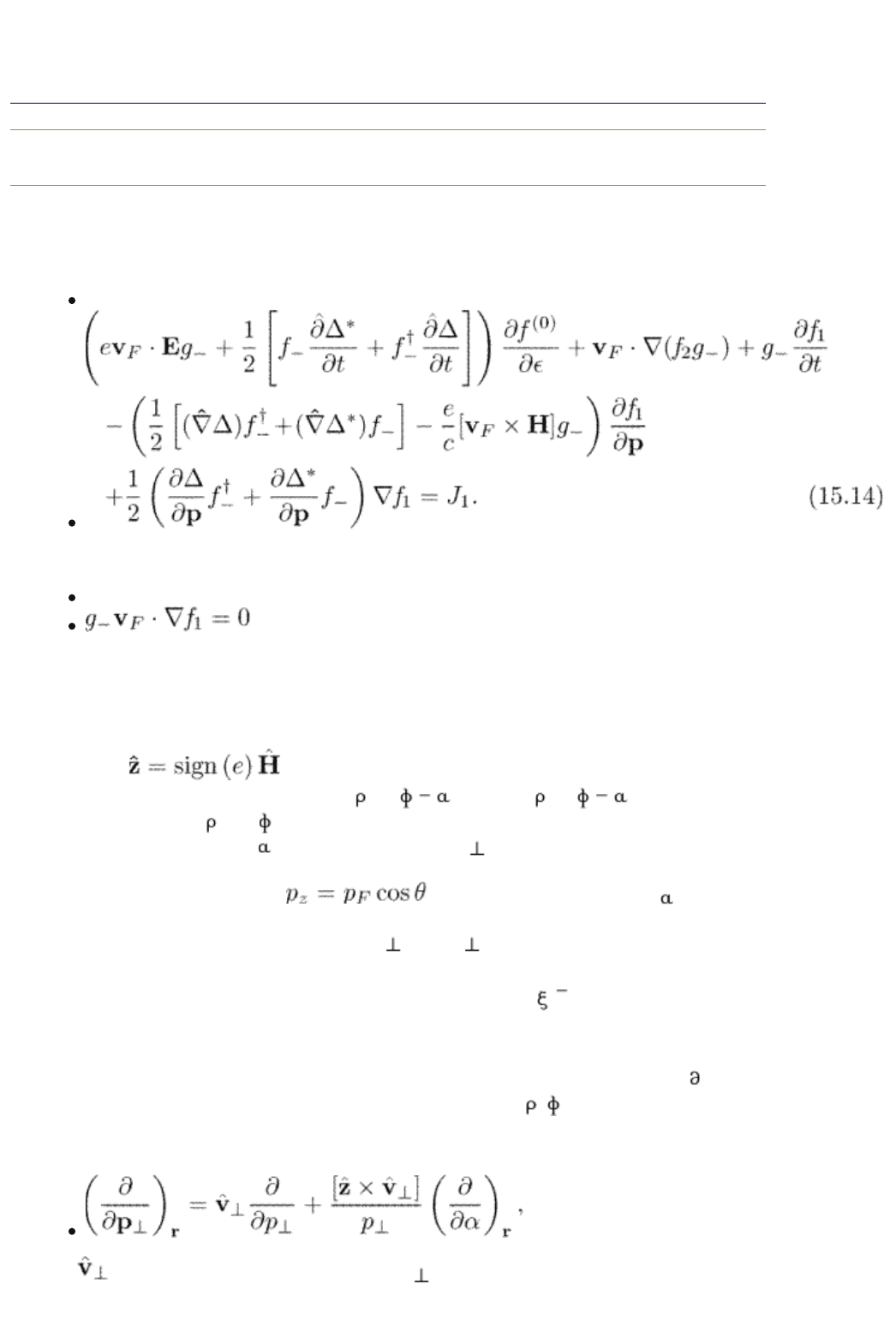
consider two more examples of implementation of this scheme. In Section 15.4
we calculate the vortex mass. Another example is the vortex dynamics in d-wave
superconductors to be discussed in Section 15.5.
end p.307
15.3.1 Transformation into the Boltzmann equation
Let us write the kinetic equations (10.41) and (10.56) again. We have
(15.14)
and
(15.15)
We start with a few preparatory steps before transforming the kinetic equation
(15.14) into the Boltzmann equation. We again use the coordinate frame
associated with the vortex as shown in Fig. 6.1. Recall that the z-axis is chosen
parallel to the axis of the vortex, with the positive direction along the vortex
circulation
. The distance along the quasiparticle trajectory as
well as the impact parameter are s =
cos( ) and b = sin( ),
respectively, where
and are the radial distance and the azimuthal angle in
the cylindrical frame, and
is the angle between v and the x-axis. In this
representation, the quasiclassical Green function is specified by the momentum
projection on the vortex axis
, the momentum direction in the
plane perpendicular to the vortex axis, and the impact parameter b, which is
related to the angular momentum µ = bp
, with p the momentum projection
on the plane perpendicular to the vortex axis. For simplicity, we consider a
spherical Fermi surface here. Up to corrections of order (p
F
)
1
we can assume
straight quasiparticle trajectories and thus the angular momentum µ is a
conserved quantity even for a non-axisymmetric vortex.
Next, we transform the operators in eqn (15.14). The momentum derivative
p
in eqn (15.14) is taken at a constant position vector r = (
, ) with respect to
variations in the momentum direction, with the magnitude of the momentum
being fixed at the Fermi surface. The planar projection can be written as
with the unit vector in the direction of v . Changing to variables s and b,
PRINTED FROM OXFORD SCHOLARSHIP ONLINE (www.oxfordscholarship.com)
© Copyright Oxford University Press, 2003-2010. All Rights Reserved
Oxford Scholarship Online: Theory of Nonequilibrium Supe... http://www.oxfordscholarship.com/oso/private/content/phy...
第3页 共6页 2010-8-8 16:11
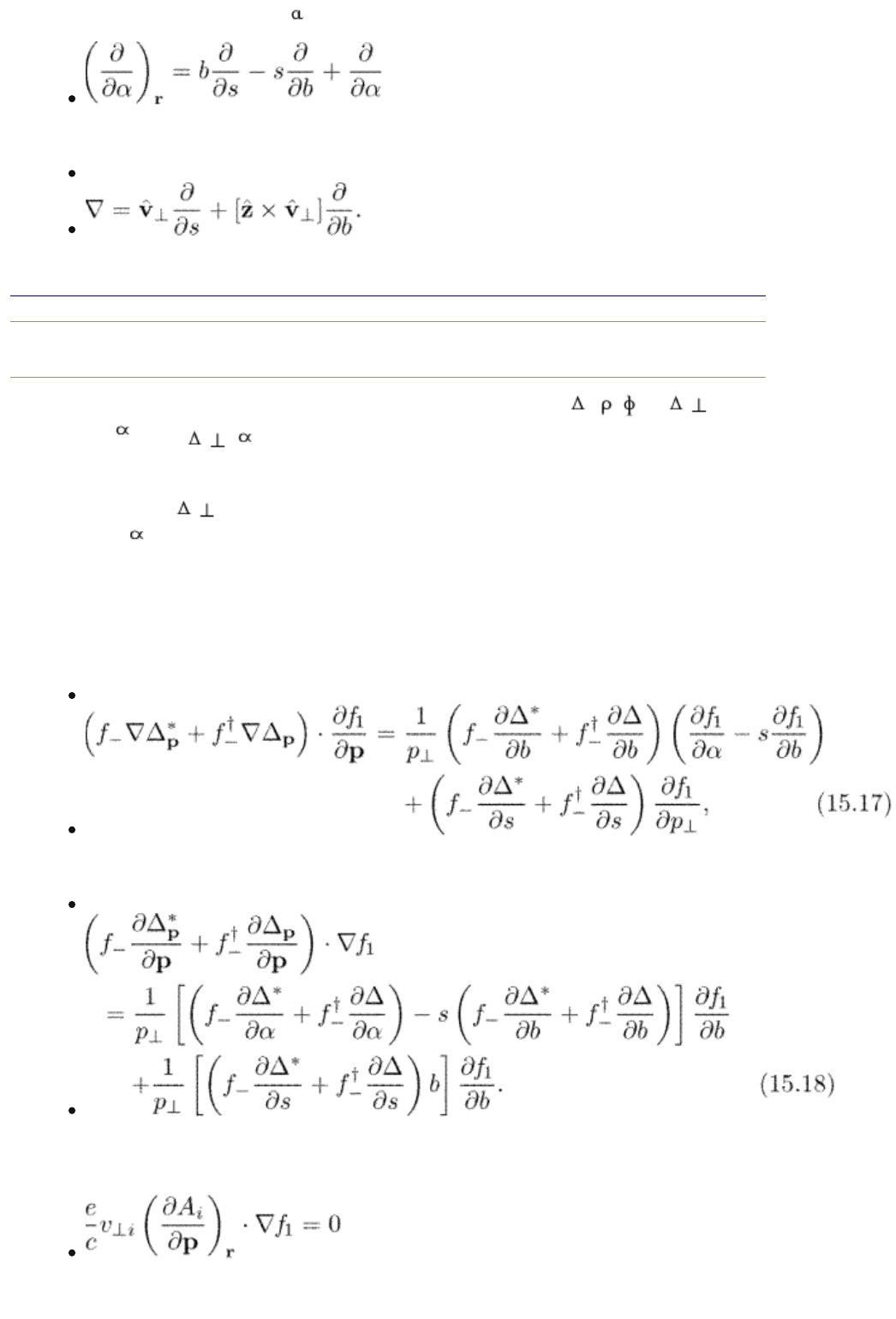
the derivative with rospect to becomes
and the spatial gradient in the (s, b) frame is
(15.16)
end p.308
In the presence of a vortex, the order parameter has the form
p
( , ) =
p
(a, s, b)e
i
. Here
p
( , s, b) is the order parameter expressed in the
coordinate frame (s, b), where the azimuthal angle is measured from the
momentum direction. For a non-axisymmetric vortex and/or in a d-wave
superconductor,
p
(a, s, b) can have an explicit dependence on the angular
coordinate
.
To work with various terms in the kinetic equation (15.14) we use
transformations very similar to those we made in Section 14.2 to derive
identities for the quasiclassical Green functions. Keeping in mind that f
1
is
independent of s (see eqn (15.15)), we rewrite the terms in the second and third
lines of eqn (15.14) in the form
(15.17)
and
(15.18)
Moreover, since A floes not depend on the momentum direction, we can subtract
the zero term
from the third line of eqn (15.14). Next, we integrate (15.14) along the
PRINTED FROM OXFORD SCHOLARSHIP ONLINE (www.oxfordscholarship.com)
© Copyright Oxford University Press, 2003-2010. All Rights Reserved
Oxford Scholarship Online: Theory of Nonequilibrium Supe... http://www.oxfordscholarship.com/oso/private/content/phy...
第4页 共6页 2010-8-8 16:11
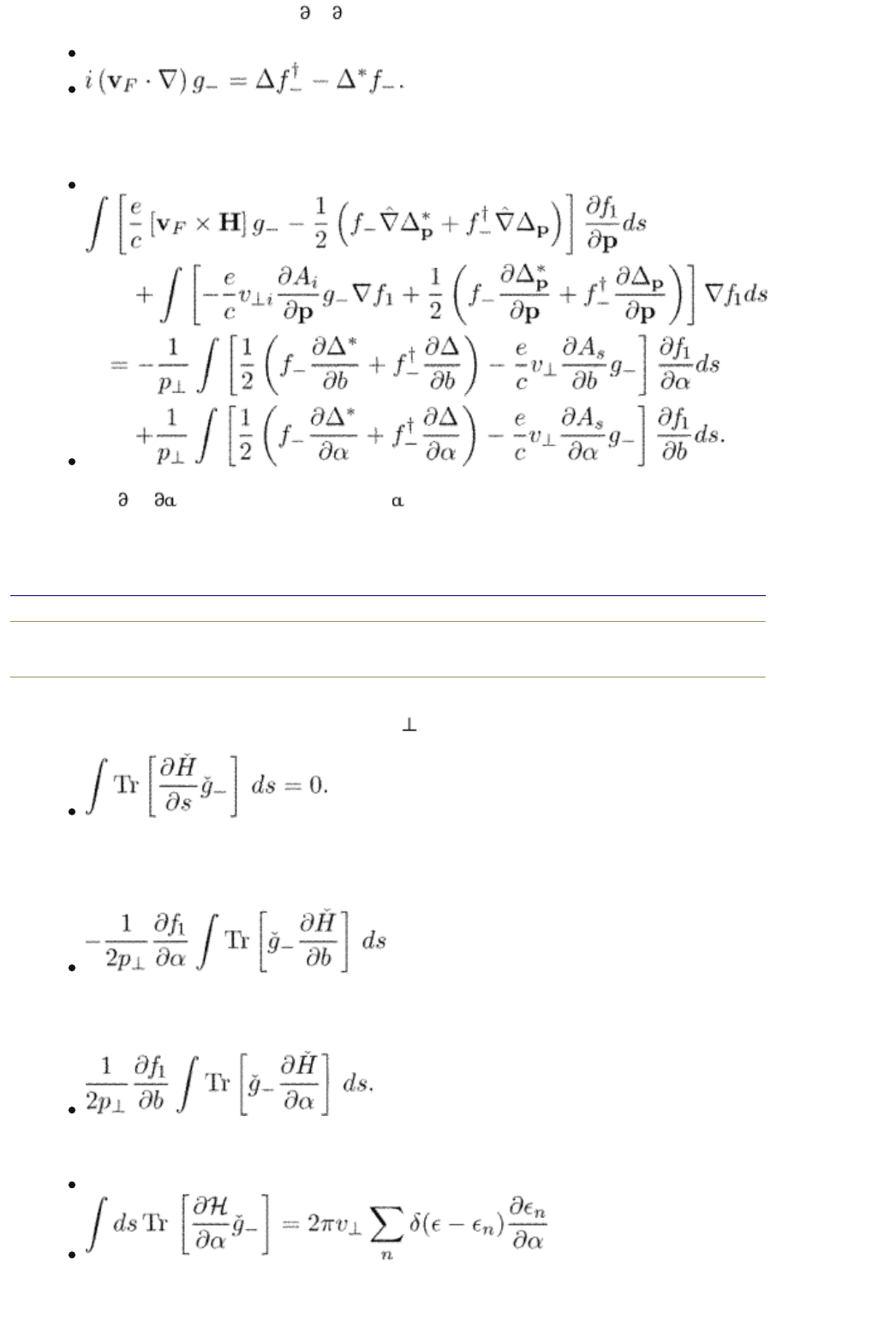
quasiclassical trajectory, using f
1
/ s = 0 and one of the Eilenberger equations,
(15.19)
After some algebra the second and third lines in the l.h.s. of eqn (15.14) take the
form
(15.20)
The term A
s
/ accounts for the explicit -dependence picked up by the vector
potential when expressed in the coordinate frame (s, b). The s-derivatives
present
end p.309
in eqns (15.17) and (15.18) disappear in eqn (15.20), as can be seen from the
identity (14.29). In particular, taking the v
projection of eqn (14.29) we find,
It is this relation which serves to eliminate the s-derivatives from eqn (15.20).
The first term in the r.h.s. of eqn (15.20) has the form
which can also be transformed with the help of eqn (14.29). The second term has
the form
It can be transformed using the relation
(15.21)
which can easily be derived in exactly the same way as eqn. (14.29). As a result,
PRINTED FROM OXFORD SCHOLARSHIP ONLINE (www.oxfordscholarship.com)
© Copyright Oxford University Press, 2003-2010. All Rights Reserved
Oxford Scholarship Online: Theory of Nonequilibrium Supe... http://www.oxfordscholarship.com/oso/private/content/phy...
第5页 共6页 2010-8-8 16:11
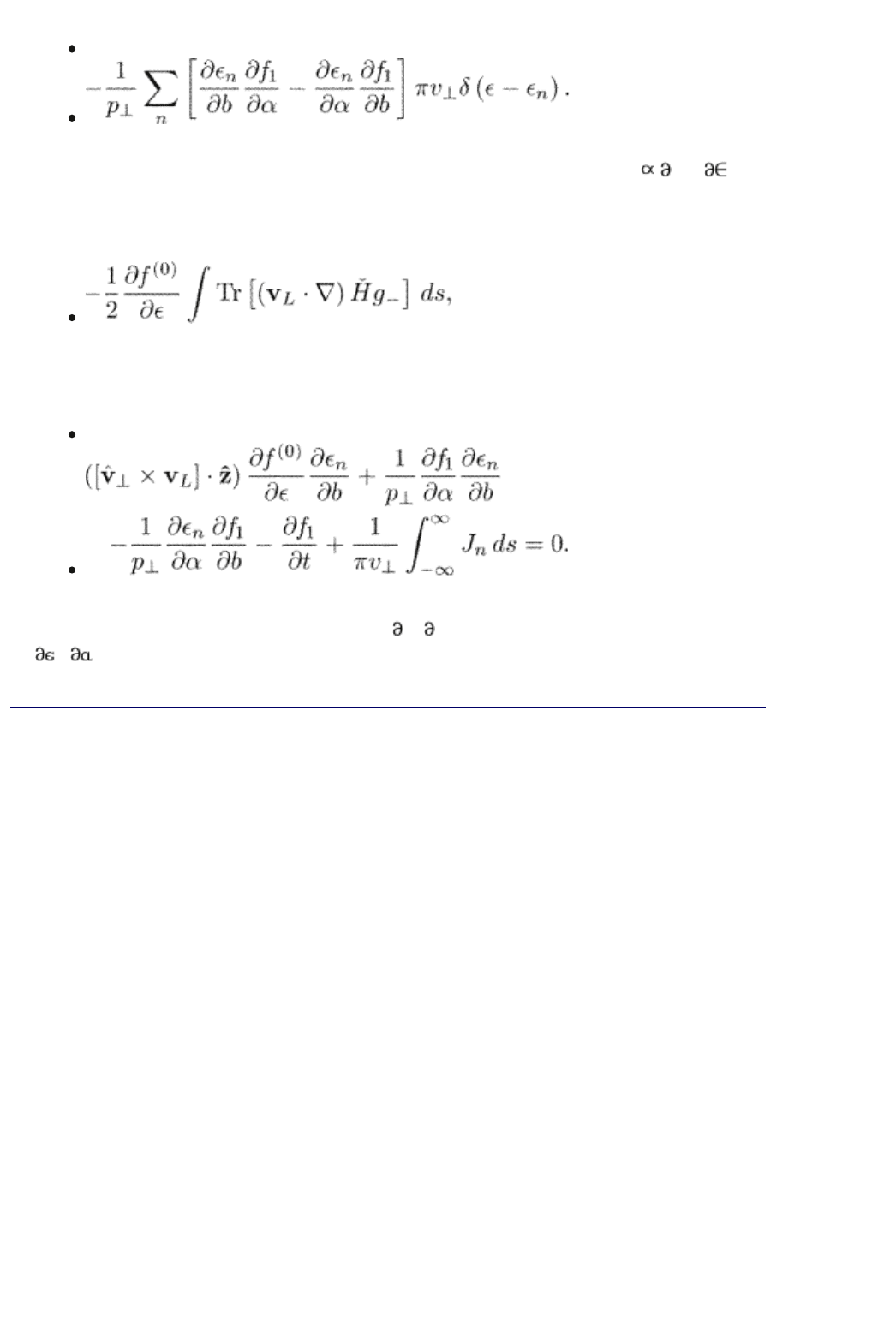
the r.h.s. of eqn (15.20) takes the simple form
(15.22)
Next, we concentrate on the first line of eqn (15.14). The driving term f
(0)
/
is the source of the nonequilibrium state as produced by time variations of the
order parameter together with the electric field. According to eqn (14.38), the
first term of the kinetic equation (15.14) can be written in the form
which then can be further transformed using eqn (14.29). The second term in the
first line of eqn (15.14) vanishes after integration over ds. The next term can be
transformed with help of the identity (14.25). We finally obtain
(15.23)
A similar equation (14.42) has been already derived in Section 14.4 for s-wave
superconductors. Note that the term with
f
1
/ b is absent in eqn (14.42) because
n
/ = 0 for an axisymmetric vortex in an s-wave superconductor.
end p.310
Top
Privacy Policy and Legal Notice © Oxford University Press, 2003-2010. All rights reserved.
Oxford Scholarship Online: Theory of Nonequilibrium Supe... http://www.oxfordscholarship.com/oso/private/content/phy...
第6页 共6页 2010-8-8 16:11

Equation (15.23) is nothing but the Boltzmann equation (14.3) used in the
beginning of this chapter. Indeed, consider various terms in eqn (15.23) and
compare them with eqn (14.3). Since
we have from eqn (15.23)
(15.24)
with
n
=
n
( , ; p
z
) and = bp . We denoted the collision integral as
(15.25)
The time-derivative term in eqn (14.3) is obtained from eqn (15.24) if we
assume that the energy
n
contains a time dependence through the impact
parameter
, where (t) = [(r v
L
t) × p] :
(15.26)
and combine it with f
1
/ t in the total distribution function f = f
(0)
(
n
) + f
1
.
Equation (14.3) can be rewritten into the generic form (15.1) with the canonical
variables q =
and p = .
To summarize the results of this section, we have started with the exact
microscopic description of the nonstationary processes in terms of the Green
function technique. Using the quasiclassical approximation, we have been able to
reduce the problem of finding the nonequilibrium state of the superconductor
with a moving vortex to the problem of solving the canonical Boltzmann equation
for the distribution of nonequilibrium excitations localized in the vortex core. The
only information needed to find the distribution function is the energy spectrum
of the equilibrium excitations in the vortex core. The knowledge of the energy
spectrum is also sufficient to calculate the force acting on the moving vortex. The
full problem of the vortex dynamics thus reduces to several much easier and
more transparent steps which are: finding the equilibrium energy spectrum of
the excitations in the vortex core, solving the Boltzmann equation, and, finally,
calculating the momentum transfer from the localized excitations.
15.4 Vortex mass
Kopnin, Nikolai, Senior Scientist, Low Temperature Laboratory, Helsinki University of
Technology, and L.D. Landau Institute for Theoretical Physics, Moscow
Theory of Nonequilibrium Superconductivity
Print ISBN 9780198507888, 2001
pp. [311]-[315]
Oxford Scholarship Online: Theory of Nonequilibrium Supe... http://www.oxfordscholarship.com/oso/private/content/phy...
第1页 共6页 2010-8-8 16:12
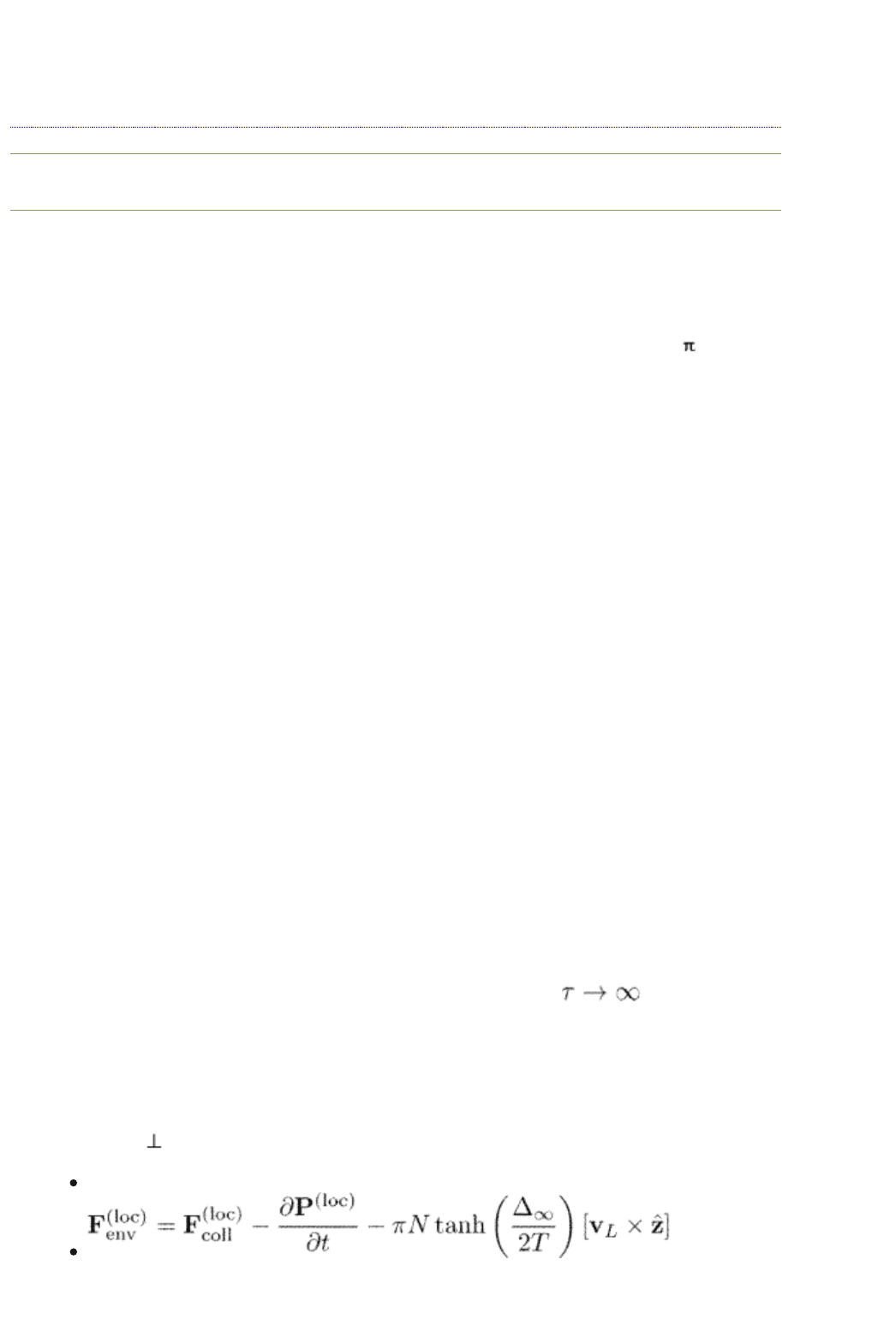
The vortex mass in superfluids and superconductors has been a long-standing
problem in vortex physics and remains to be an issue of controversies. There are
different approaches to its definition. In early works on this subject, the vortex
mass was determined through an increase in the free energy of a superconductor
end p.311
calculated as an expansion of retarded and advanced Green functions up to the
second order terms in slow time-derivatives of the order parameter. The
quasiparticle distribution was assumed to be essentially in equilibrium. First used
by Suhl (1965) (see also Duan and Leggett 1992) this approach yields the mass
of the order of one quasipaticle mass (electron, in the case of a superconductor)
per atomic layer. Another approach consists in calculating the energy E
2
/8 of
electric field which is proportional to the square of the vortex velocity. This gives
rise to the so-called electromagnetic mass (Coffey and Hao 1991) which, in good
metals, is of the same order of magnitude (see Sonin et al. 1998 for a review).
A serious disadvantage of the above definitions of the vortex mass is that they do
not take into account the kinetics of excitations disturbed by a moving vortex.
We shall see that the inertia of excitations contributes much more to the vortex
mass than what the old calculations predict. The kinetic equation approach
described here is able to incorporate this effect. To implement this method we
find the force necessary to support an unsteady vortex motion. Identifying then
the contribution to the force proportional to the vortex acceleration, one defines
the vortex mass as a coefficient of proportionality. This method was first applied
for vortices in superclean superconductors by Kopnin (1978) and then was used
by other authors (see for example, Kopnin and Salomaa 1991, Šimánek 1995).
The resulting mass is of the order of the total mass of all electrons within the
area occupied by the vortex. We will refer to this mass as to the dynamic mass.
The dynamic mass originates from the inertia of excitations and can also be
calculated as the momentum carried by localized excitations (Volovik 1997).
In the present section we describe how one can apply our kinetic equation
approach for calculating the dynamic vortex mass in a general case of a finite
relaxation time of nonequilibrium excitations produced by the moving vortex.
Following Kopnin and Vinokur (1998) we use the Boltzmann kinetic equation to
derive the equation for the vortex dynamics which contains the inertia term
together with all the forces acting on a moving vortex. We shall see that dynamic
mass displays a nontrivial feature: it is a tensor whose components depend on
the quasiparticle mean free time. In s-wave superconductors, this tensor is
diagonal in the superclean limit. The diagonal mass decreases rapidly as a
function of the mean free time, and the off-diagonal components dominate in the
moderately clean regime. Our results agree with the previous work (Kopnin
1978, Kopnin and Salomaa 1991, Volovik 1997) in the limit
.
15.4.1 Equation of vortex dynamics
To introduce the vortex momentum we consider a non-steady motion of a vortex
with a small acceleration. We start with localized excitations. Multiplying eqn
(15.24) by p
/2 and summing up over all the quantum numbers, we obtain
(15.27)
where the l.h.s. of eqn (15.27) is the force from the environment on a moving
PRINTED FROM OXFORD SCHOLARSHIP ONLINE (www.oxfordscholarship.com)
© Copyright Oxford University Press, 2003-2010. All Rights Reserved
Oxford Scholarship Online: Theory of Nonequilibrium Supe... http://www.oxfordscholarship.com/oso/private/content/phy...
第2页 共6页 2010-8-8 16:12
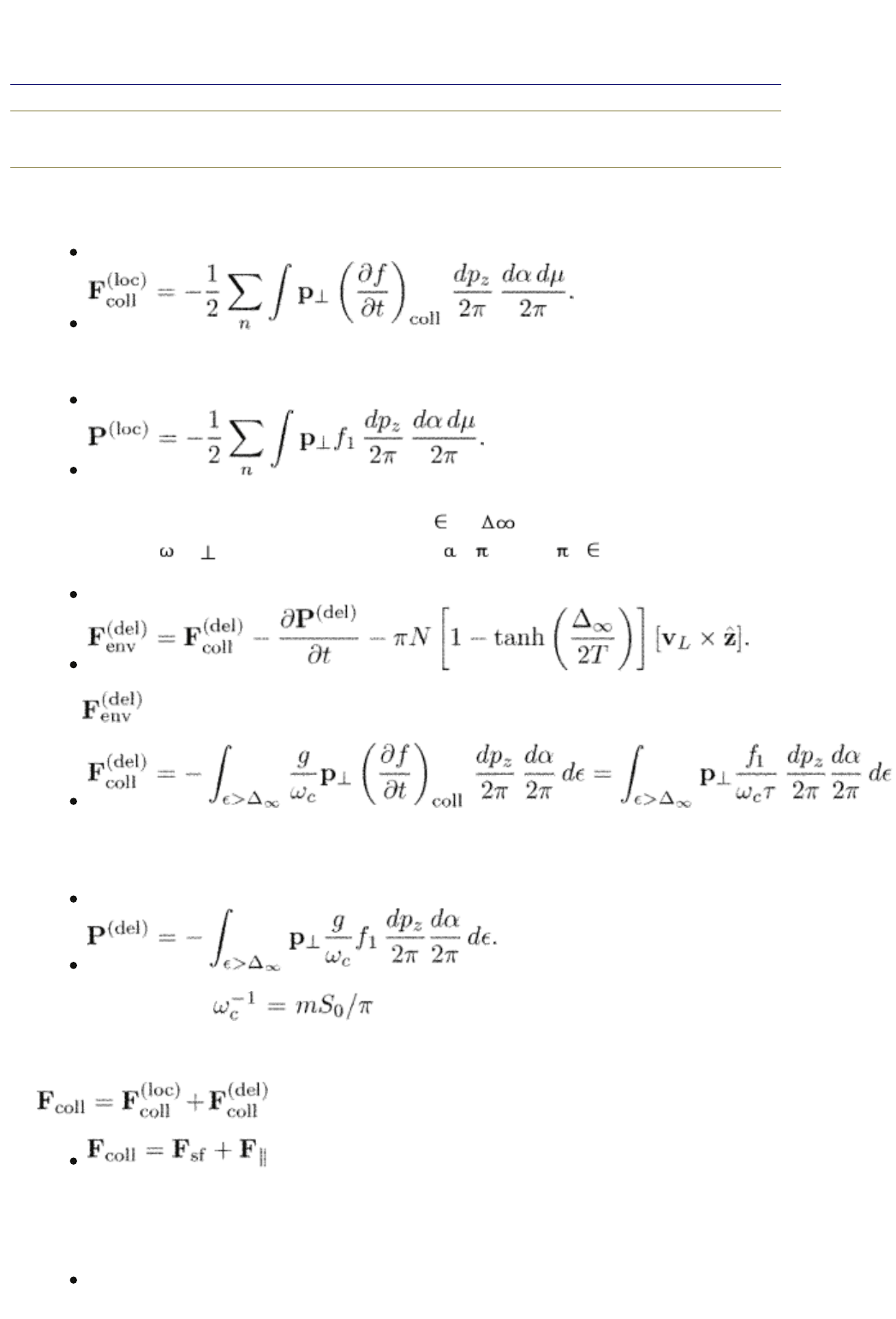
vortex eqn (14.4) derived in Section 14.5. The first term in the r.h.s. of eqn
(15.27)
end p.312
is the force exerted on the vortex by the heat bath via excitations localized in the
vortex core:
(15.28)
The second term in the r.h.s. of (15.27) is the change in the vortex momentum
(15.29)
To find the contribution from the states with | | > we multiplying eqn
(15.11) by (g/
c
)p /2 and integrate it over (d /2 ) (dp
z
/2 )d . We obtain
(15.30)
Here is determined by eqn (14.65),
is the force from the heat bath, while the corresponding contribution to the
vortex momentum is
(15.31)
Note that the factor is proportional to the particle mass and to
the area occupied by each vortex. The total momentum is P = P
(loc)
+ P
(del)
.
After a little algebra, the total force from the heat bath
can be written in the form
where the friction and spectral flow forces are determined by eqns (14.87) and
(14.93), respectively. The total force from environment eqns (15.27) and (15.30)
takes the form
(15.32)
PRINTED FROM OXFORD SCHOLARSHIP ONLINE (www.oxfordscholarship.com)
© Copyright Oxford University Press, 2003-2010. All Rights Reserved
Oxford Scholarship Online: Theory of Nonequilibrium Supe... http://www.oxfordscholarship.com/oso/private/content/phy...
第3页 共6页 2010-8-8 16:12

This equation agrees with eqn (14.91) for a steady motion of vortices.
The equation of vortex dynamics is obtained by variation of the superconducting
free energy plus the external field energy with respect to the vortex
displacement. The variation of the superfluid free energy gives the force from the
environment, F
env
, while the variation of the external field energy produces the
external Lorentz force. In the absence of pinning the total energy is
translationally invariant. Therefore, the requirement, of zero variation of the free
energy again gives the condition F
L
+ F
env
= 0 in the form of the force balance.
Using
end p.313
our expression for F
env
the force balance can now be written in the form similar
to eqn (14.96)
(15.33)
where the r.h.s. contains the time-derivative of the vortex momentum due to a
non-steady vortex motion. For a steady vortex motion, eqn (15.33) reduces to
eqn (14.99). The physical meaning of the eqn (15.33) is simple. The l.h.s. of this
equation accounts for all the forces acting on a moving straight vortex line. The
r.h.s. of eqn (15.33) comes from the inertia of excitations and is identified as the
change in the vortex momentum. This definition of momentum is similar to that
used by Stone (1996) and by Volovik (1997).
15.4.2 Vortex momentum
Having defined the vortex momentum, we calculate the vortex mass. The
distribution function is given by eqn (14.9). The vortex momentum becomes P
i
=
M
ik
u
k
; it has both longitudinal and transverse components with respect to the
vortex velocity. For a vortex with the symmetry not less than the four-fold, the
effective mass tensor per unit length is M
ik
= M
|| ik
M e
ikj j
where M
||
= M
||e
+
M
||h
, and M = M
e
= M
h
. Each component contains contributions from
localized and delocalized states such that
where
(15.34)
and
(15.35)
The same expression holds for M
e,h
where
H
is replaced with
O
. The e, h
PRINTED FROM OXFORD SCHOLARSHIP ONLINE (www.oxfordscholarship.com)
© Copyright Oxford University Press, 2003-2010. All Rights Reserved
Oxford Scholarship Online: Theory of Nonequilibrium Supe... http://www.oxfordscholarship.com/oso/private/content/phy...
第4页 共6页 2010-8-8 16:12
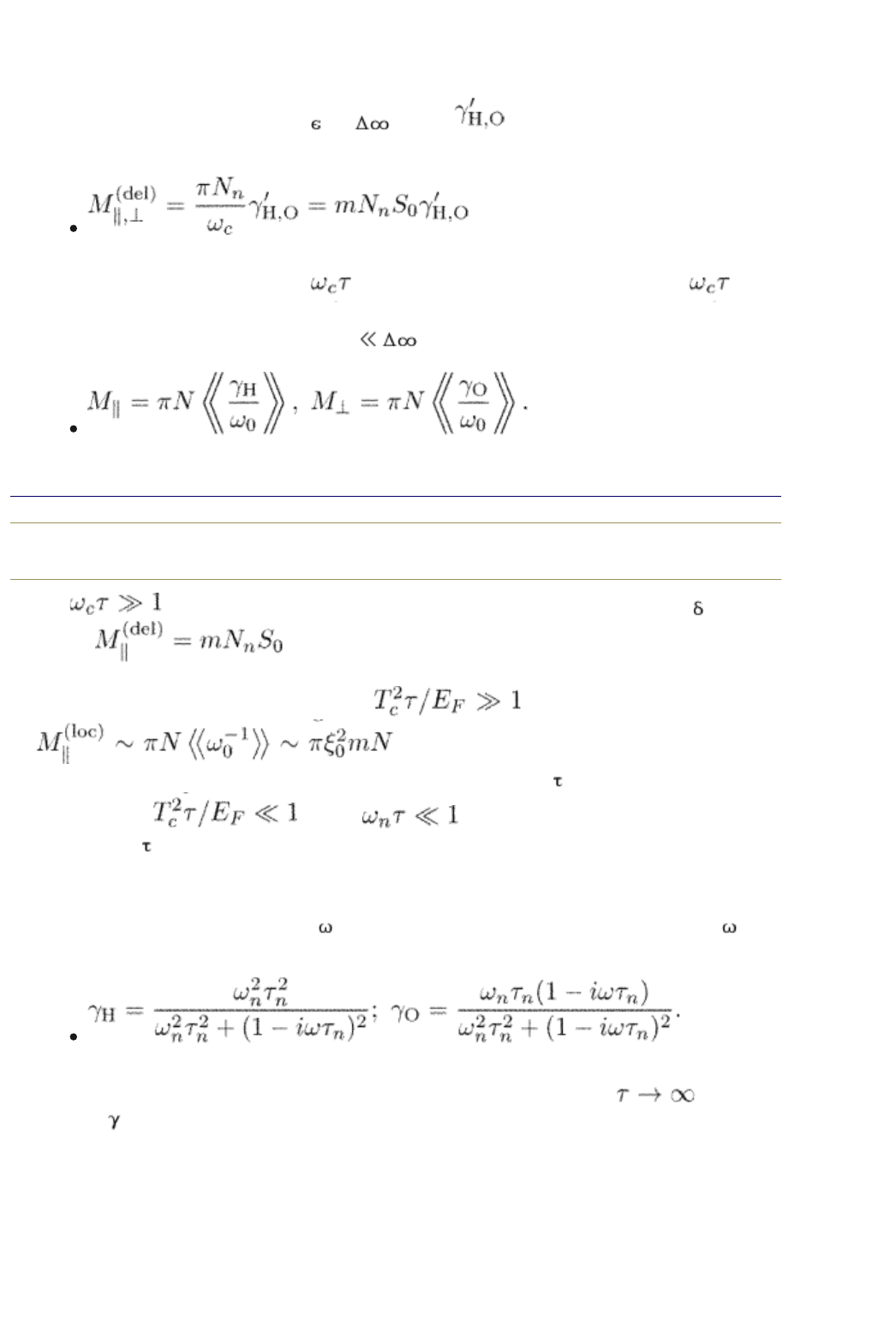
subscripts indicate the corresponding momentum integrations over the electron
and hole parts of the Fermi surface, respectively.
If the vortex acceleration is slow, one can use expressions (14.14), (14.54) for a
steadily moving vortex to calculate the vortex inertia. Consider first the
contribution of the states with |
| > . Since do not depend on energy
and momentum, eqn (15.35) gives
Here N
n
is the density of normal particles (or holes). The contribution of the
delocalized states decreases as
gets smaller. In the limit of vanishing
the vortex mass is determined by localized excitations. The localized excitations
dominate also at low temperatures T
. One has in this case
end p.314
For 1 the mass tensor for delocalized states is diagonal M
ik
= M
|| ik
where ; it is equal to the mass of all normal particles in the
area occupied by the vortex. The mass tensor for localized states becomes
diagonal in the superclean limit where
with
. This is the mass of all electrons in the
area occupied by the vortex core. The mass decreases with
. In the moderately
clean regime
where , the diagonal component
vanishes as
2
, and the mass tensor is dominated by the off-diagonal part.
We should emphasize an important point that, in contrast to a conventional
physical body, the mass of a vortex is not a constant quantity for a given system:
it may depend on the frequency
of the external drive. Indeed, for a nonzero
we find from eqn (15.24)
As a result, all the dynamic characteristics of vortices including the conductivity
and the effective mass acquire a frequency dispersion. In the limit
,
poles in
O,H
appear at a frequency equal to the energy spacing between the
quasiparticle states in the vortex core which gives rise to resonances in
absorption of an external electromagnetic field (Kopnin 1978, 1998 b).
15.5 Vortex dynamics in d-wave superconductors
In this section we consider the vortex dynamics in d-wave superconductors at low
temperatures. We specify later which temperatures can he considered as low. In
PRINTED FROM OXFORD SCHOLARSHIP ONLINE (www.oxfordscholarship.com)
© Copyright Oxford University Press, 2003-2010. All Rights Reserved
Oxford Scholarship Online: Theory of Nonequilibrium Supe... http://www.oxfordscholarship.com/oso/private/content/phy...
第5页 共6页 2010-8-8 16:12

d-wave superconductors, the vortex dynamics is expected to be more intricate
due to a peculiar structure of the vortex-core stales. The presence of gap nodes
introduces the most import ant difference in the structure of core states
compared to an s-wave superconductor. As was shown in Section 6.4, instead of
a well-defined quasiclassical Caroli–de Gennes–Matricon interlevel spacing
0
,
the true quantum states in d-wave superconductors have a much smaller
separation
0
between quantum levels, , which depends
on the magnetic field. As a result, there appears another parameter
which
influences the vortex dynamics. We shall see that a new regime can he reached
in superclean superconductors with longitudinal and transverse components of
the conductivity tensor independent of the quasiparticle mean free time (Kopnin
and Volovik 1997, Kopnin 1998 b). It is realized when the relaxation rate is
smaller than the average distance between the quasiclassical energy levels
but larger than the separation between the true quantum-
mechanical states
0
.
15.5.1 Distribution function
Here we employ the Boltzmann kinetic equation derived earlier in this chapter.
We also use the spectrum of excitations in the vortex core calculated in Section
6.4. In d-wave superconductors, the gap at large distances from the vortex has
the form
|sin(2
0
)|. A particle is classically localized within the vortex core
end p.315
Top
Privacy Policy and Legal Notice © Oxford University Press, 2003-2010. All rights reserved.
Oxford Scholarship Online: Theory of Nonequilibrium Supe... http://www.oxfordscholarship.com/oso/private/content/phy...
第6页 共6页 2010-8-8 16:12
